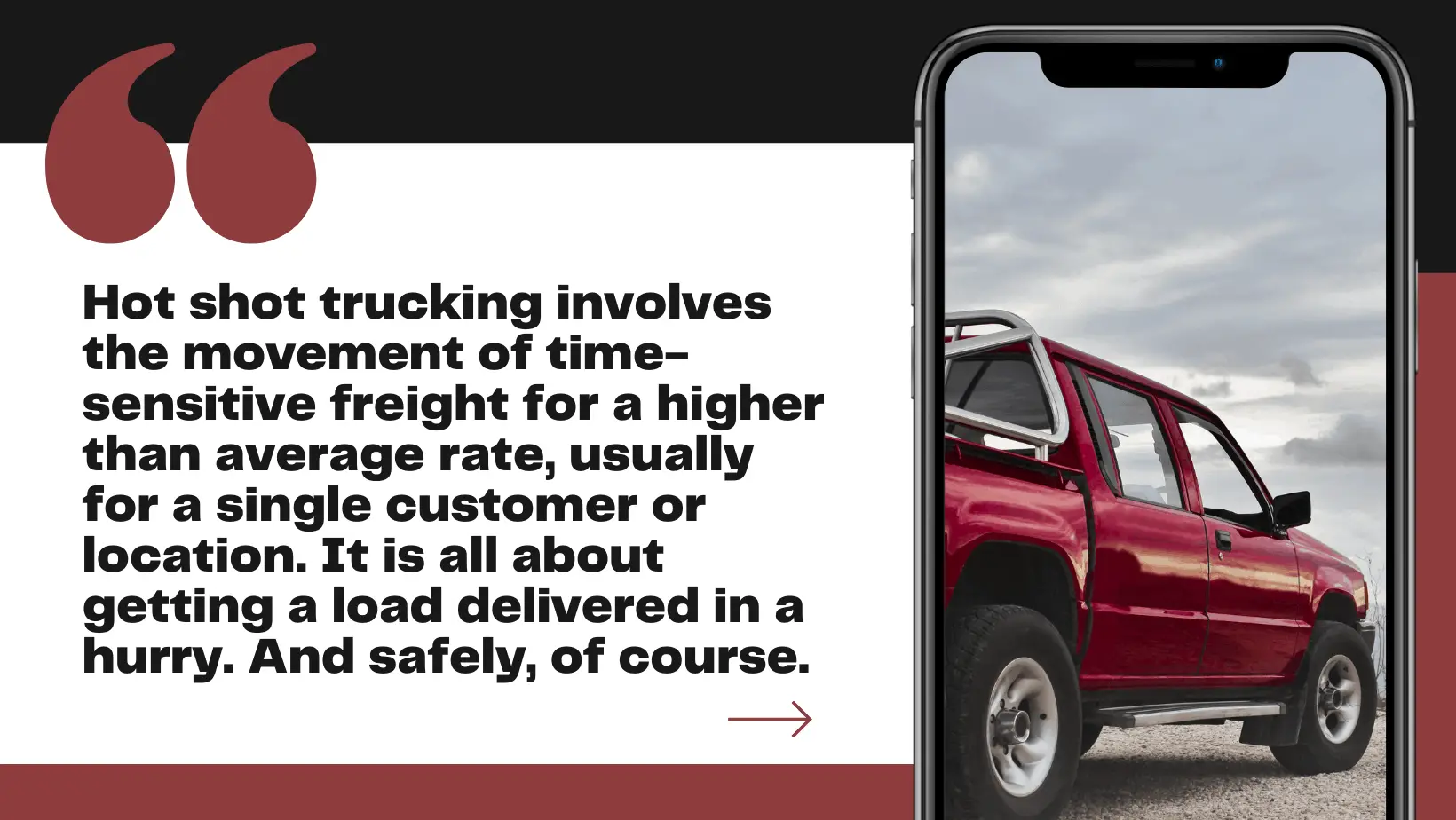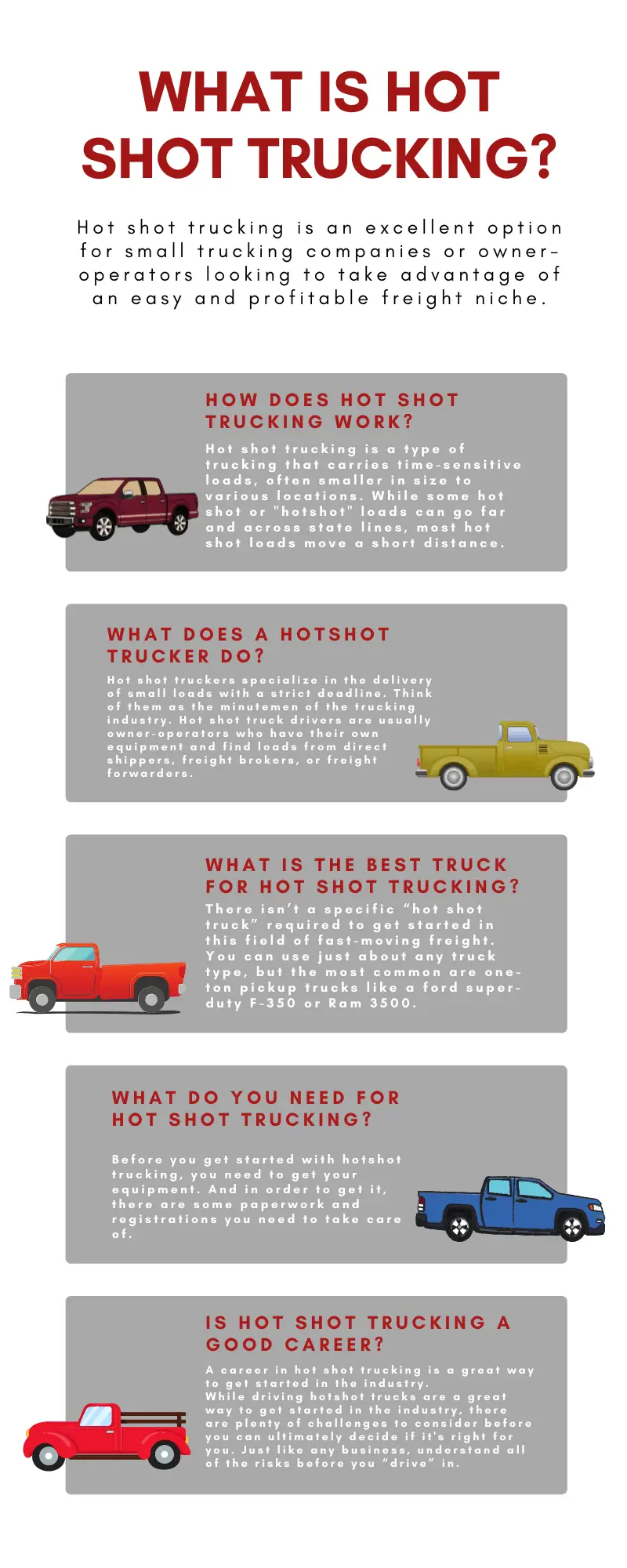Hot shot trucking is an excellent option for small trucking companies or owner-operators looking to take advantage of an easy and profitable freight niche.
Hot shot trucking refers to a type of expedited freight service where smaller, often non-commercial, trucks are used to transport time-sensitive cargo. It offers quick and efficient delivery for smaller loads, making it a popular choice for businesses and individuals needing prompt transportation solutions. Discover what sets hot shot trucking apart and how it can benefit your shipping needs.
While it's not any harder than traditional trucking, it does require a special set of equipment and skills, which is what I’ll be discussing as we go further in this article.
How Does Hot Shot Trucking Work?
Hot shot trucking is a type of trucking that carries time-sensitive loads, often smaller in size to various locations. While some hot shot or "hotshot" loads can go far and across state lines, most hot shot loads move a short distance.
This makes hot shot trucking a great opportunity for a beginner owner operator to start their trucking company or make some extra money on the side.
What Does a Hotshot Trucker Do?
Hot shot truckers specialize in the delivery of small loads with a strict deadline. Think of them as the minutemen of the trucking industry. Hot shot truck drivers are usually owner-operators who have their own equipment and find loads from direct shippers, freight brokers, or freight forwarders.
Hot shot drivers have knowledge and experience shipping commodities like equipment, chemicals, machinery, machine parts, and raw materials used for production. Independent drivers flock to hot shot loads because of the premium rates companies will pay to meet strict deadlines.
Shippers will choose to use a hot shot truck to avoid losing thousands of dollars in lost productivity. If a late delivery can cause downtime at a plant, project delays, lost revenue, or hurt a customer relationship, a hot shot delivery is usually the way to go.
What is the Best Truck for Hot Shot Trucking?
There isn’t a specific “hot shot truck” required to get started in this field of fast-moving freight. You can use just about any truck type, but the most common are one-ton pickup trucks like a ford super-duty F-350 or Ram 3500.
Most operators choose equipment that falls under the “medium-duty” class of pickups due to the long miles that wear down light-duty trucks.
Hot shot trucks typically fall under classes 3, 4, or 5.
Class 3
This class of truck has a GVWR of 10,001–14,000 pounds or 4,536–6,350 kilograms. Examples include Chevrolet Silverado 3500, the GMC Sierra 3500, the Ford F-350, and the Ram 3500.
These are your typical heavy-duty pickup trucks commonly used by contractors and some farmers. Their efficient fuel mileage and significant towing power make them an excellent option for hot shot logistics.
Class 4
This class of truck has a GVWR of 14,001–16,000 pounds or 6,351–7,257 kilograms. Examples include Chevrolet Silverado 4500, Ford F-450, and the Ram 4500.
These are heavier duty trucks and just miss qualifying as a commercial vehicle. Class 4 trucks are perfect if you are planning to haul heavier hot shot loads across long distances.
Class 5
This class of truck has a GVWR of 16,001–19,500 pounds or 7,258–8,845 kilograms. Examples include Chevrolet Silverado 5500, Ford F-550, and the Ram 5500.
Class 5 trucks are the lightest commercial-classified vehicles. This vehicle class includes larger walk-ins and delivery trucks perfect for driving long and heavy hot shot routes
Best Loadboard to Find Hotshot Loads?
When it comes to finding the best load board for hot shot drivers, look no further than DAT Truckersedge . With its comprehensive features and industry-leading platform, DAT Truckersedge is the ultimate solution for connecting hot shot drivers with profitable loads.
You can sign up for DAT Truckersedge with our link here and receive a full month for Free if you are a new subscriber.
As a hot shot driver, time is of the essence, and efficiency is key. DAT Truckersedge understands this, offering a user-friendly interface that allows you to search, filter, and sort through a vast database of available loads. Whether you're hauling expedited freight or smaller loads, DAT Truckersedge provides a seamless experience for finding the right opportunities.
When it comes to finding the best load board for hot shot drivers, DAT Truckersedge stands out as the top choice. Its comprehensive features, extensive load database, and user-friendly platform make it the go-to solution for maximizing your hot shot business's potential. Sign up with DAT Truckersedge today and take your hot shot trucking to new heights.
What is the Best Trailer for Hotshot?
The best trailer is the one that matches the type of loads you intend to haul. Choosing a trailer is an important business decision for an owner-operator. All of the freight you can haul depends on the strength and size of your trailer.
These are the different trailers that are commonly used for hotshot trucking:
Bumper Pull Trailers
This is the most common trailer for hotshot truckers. They are a popular choice because they are the most versatile. In addition, they are easy to use and more affordable than some larger trailer types.
I do recommend this trailer because it doesn’t require you to get a CDL, making it a perfect entry-level trailer for the start-up hot shot driver. The downside to bumper pull trailers is that they can’t carry as much weight as other trailers. With a max weight of 10,001 pounds, you are limited to the freight you can haul.
Gooseneck Trailers
Gooseneck trailers provide more stability than bumper pulls. They carry larger and heavier loads and are a great entry point if you are determined to make serious money in hot shot trucking.
Tilt-Deck Trailers
These trailers are safe, efficient and can carry heavier cargo like cars and building equipment. With a hydraulic tilt system, you can easily load large items without using a heavy lift crane.
Its usefulness isn’t without its own challenges. Tilt decks require a little more maintenance and oil changes due to their hydraulic systems.
Dovetail Trailers
Any hot shot driver with a preference for loading cars or anything with wheels chooses dovetail trailers. They are affordable, easy to operate, and, more importantly, easy to resell when you no longer need them.

What Do You Need for Hot Shot Trucking?
Before you get started with hotshot trucking, you need to get your equipment. And in order to get it, there are some paperwork and registrations you need to take care of.
Even if you are driving a smaller Class 3 truck, you have to register your vehicle as commercial since you’ll be using it for your business. It’s the best thing to don’t want to face steep fines and penalties.
As an independent owner operator, it is your responsibility to comply with the government ELD (Electronic Log) mandate. The good news is if you are driving a vehicle and trailer weighing less than 10,001 pounds you may be exempt from keeping electronic logs.
Filings required for a hot shot trucking business include:
- A valid Commercial drivers license (CDL)
- Insurance Policy (Cargo, General, Automobile & Workmans Comp)
- USDOT number
- MC Number for interstate commerce.
- LLC formation in your state of business operations
- Knowledge of proper load securement.
If your trailer has a gross vehicle weight rating (GVWR) of 10,001 pounds or more and the gross combined weight rating (GCWR) of the truck and trailer is 26,001 pounds or more, a CDL is required.

Is Hot Shot Trucking a Good Career?
A career in hot shot trucking is a great way to get started in the industry.
If you choose to get started in Hot Shot Trucking, make sure you consider everything you need from the right equipment to the proper licensing and financial requirements to get started. While driving hotshot trucks are a great way to get started in the industry, there are plenty of challenges to consider before you can ultimately decide if it's right for you. Just like any business, understand all of the risks before you “drive” in.
Benefits of Hot Shot Trucking
Hot shot trucking has benefits for both drivers who want to drive hot shot trucks, and shippers who use hot shot services to move their goods between locations. Let’s break them down.
Advantages for Drivers
A huge benefit to hot shot trucking is that there are very low startup costs when compared to traditional trucking. Instead of a full size tractor, sleeper cab, and 53 foot dry van trailer, a hot shot requires no more than a super duty pickup truck and flatbed attachment.
This means a lower cost of materials to start and more importantly lower cost to operate which in the end puts more profit in your pocket.
Advantages for Shippers
Since hot shot truck drivers specialize in moving smaller, time sensitive loads, shippers can reliably ship their freight with confidence that they can get their loads to their destinations on time.
